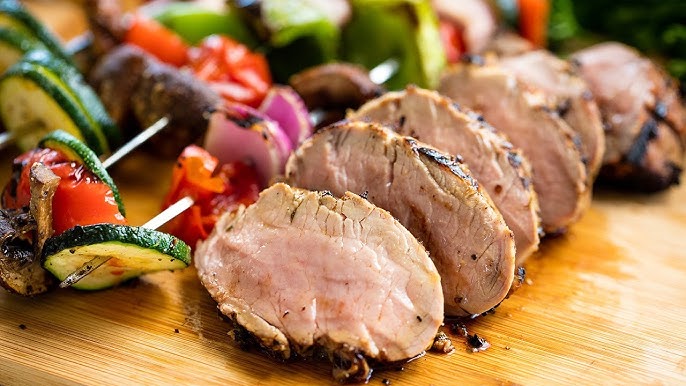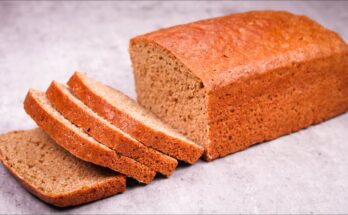Grilled Pork Tenderloin Recipe: When it comes to grilling, pork tenderloin is one of the most rewarding cuts of meat you can prepare. Known for its tenderness, lean texture, and ability to absorb flavors beautifully, it’s a go-to choice for both beginners and grilling experts. Unlike fattier cuts of pork, the tenderloin is lean and cooks quickly, which makes it ideal for weeknight dinners or backyard cookouts.
One of the best things about pork tenderloin is its versatility. It can be marinated, rubbed with spices, or glazed with sauces depending on the flavor profile you’re aiming for. You can go for smoky and bold, sweet and tangy, or even keep it simple with just salt, pepper, and olive oil. It’s a forgiving cut when prepared right, but it requires some care to avoid overcooking since it has little fat.
Grilling pork tenderloin gives it that perfect charred exterior while keeping the inside juicy and tender. Pair it with some roasted vegetables, fresh salads, or grilled corn, and you’ve got a complete meal that’s both nutritious and delicious. Whether you’re cooking for family, friends, or a special occasion, this grilled pork tenderloin recipe will become one of your favorites.
Ingredients You’ll Need
Before firing up the grill, it’s essential to gather your ingredients. Having everything ready in advance will make the cooking process smooth and enjoyable.
Core Ingredients:
- 1–2 pork tenderloins (about 1 to 1.5 pounds each)
- 3 tablespoons olive oil
- 3 cloves garlic, minced
- 2 tablespoons soy sauce
- 2 tablespoons balsamic vinegar (or apple cider vinegar)
- 2 tablespoons honey (or brown sugar for sweetness)
- 1 teaspoon Dijon mustard
- 1 teaspoon paprika
- 1 teaspoon black pepper
- 1 teaspoon salt
Optional Add-Ons for Flavor:
- Fresh rosemary or thyme for a herby touch
- Chili flakes or cayenne pepper for spice
- Lemon or orange zest for a citrusy kick
Substitutions for Dietary Needs:
- Gluten-free soy sauce or tamari for gluten-free diets
- Maple syrup instead of honey for a vegan-friendly version (if using plant-based alternatives for pork)
- Coconut aminos instead of soy sauce for a lighter sodium option
The beauty of this recipe is that it’s adaptable. You can keep it simple with just oil, garlic, salt, and pepper, or dress it up with a full marinade. By tweaking the ingredients slightly, you can personalize the dish to match your taste preferences and dietary needs.
Essential Tools and Equipment
Grilling pork tenderloin doesn’t require fancy gadgets, but having the right tools makes a big difference in achieving that perfect balance of char and juiciness.
Grilling Essentials:
- A gas or charcoal grill (depending on your preference)
- Grill brush for cleaning the grates
- Tongs for flipping without piercing the meat
Prep Tools You’ll Need:
- Mixing bowl for the marinade
- Sharp knife for trimming silver skin off the tenderloin
- Cutting board for slicing after resting
Recommended Thermometer and Accessories:
- Instant-read meat thermometer (crucial for checking doneness)
- Aluminum foil for tenting the meat while it rests
- Basting brush if applying extra marinade or glaze while grilling
Having these tools on hand will not only make the cooking process easier but also ensure that your pork tenderloin turns out juicy, flavorful, and perfectly cooked every time.
Step-by-Step Guide to Grilling Pork Tenderloin
Step 1 – Preparing the Pork Tenderloin
The first step is trimming the tenderloin. Pork tenderloin often comes with a thin, silvery membrane known as silver skin. This doesn’t break down during cooking and can make the meat chewy if left on. Use a sharp knife to carefully trim it off without removing too much of the meat. Once trimmed, pat the tenderloin dry with paper towels—this helps the marinade stick better and ensures a nice sear when grilling.
Step 2 – Making the Marinade or Rub
The marinade is where the magic happens. A good balance of salty, sweet, acidic, and savory flavors will elevate your tenderloin to the next level. Mix olive oil, soy sauce, balsamic vinegar, garlic, honey, mustard, paprika, salt, and pepper in a bowl. Whisk until well combined. If you prefer a dry rub, you can mix paprika, garlic powder, onion powder, cayenne, brown sugar, salt, and pepper for a flavorful crust.
Step 3 – Marinating for Maximum Flavor
Place the pork tenderloin in a resealable bag or shallow dish, pour the marinade over, and coat evenly. Seal and refrigerate for at least 2 hours, though overnight marination gives the best results. The longer it sits, the deeper the flavors penetrate the meat. If you’re short on time, even 30 minutes will add noticeable flavor, but patience truly pays off here.
Step 4 – Preheating the Grill Properly
Grilling success starts with heat management. Preheat your grill to medium-high heat, around 400°F (200°C). If you’re using a gas grill, simply turn the burners on and let it warm up with the lid closed for 10–15 minutes. For charcoal grills, light the coals and wait until they’re covered in white ash before spreading them evenly.
You’ll want to set up for two-zone cooking: one side of the grill should be direct heat (for searing), and the other side should be indirect heat (for cooking the pork through). This setup gives you control, allowing you to get that golden-brown crust without burning the outside before the inside is done. Brush the grates with oil before placing the pork to prevent sticking and help achieve those perfect grill marks.
Step 5 – Grilling the Tenderloin
Now comes the exciting part—grilling! Place the pork tenderloin over direct heat and sear each side for 2–3 minutes until you see a beautiful crust forming. This step locks in flavor and gives your tenderloin that classic smoky-charred exterior.
After searing, move the pork to the indirect heat side of the grill. Close the lid and let it cook for about 15–20 minutes, depending on the size of the tenderloin. Flip it halfway through for even cooking. During this stage, you can baste with extra marinade or glaze for additional layers of flavor.
The key is not to rush. Pork tenderloin is lean, which means it can dry out easily if overcooked. Keeping it on indirect heat ensures it cooks evenly without losing its juiciness.
Step 6 – Checking Internal Temperature
The most critical part of grilling pork tenderloin is getting the doneness right. Use an instant-read meat thermometer to check the internal temperature at the thickest part of the meat. For juicy, tender pork, you want to aim for 145°F (63°C).
At this temperature, the pork will be slightly pink in the center, which is safe and perfectly delicious according to USDA guidelines. If you prefer it more well-done, you can cook it closer to 155°F (68°C), but keep in mind that going higher risks drying it out.
Avoid guessing or cutting into the meat too soon to check—it releases valuable juices. A thermometer ensures accuracy and guarantees you won’t end up with dry pork.
Step 7 – Resting and Slicing
Once your tenderloin hits the right temperature, remove it from the grill and tent it loosely with aluminum foil. Let it rest for about 5–10 minutes before slicing. Resting allows the juices to redistribute throughout the meat, ensuring each bite is tender and flavorful instead of dry.
When ready to serve, slice the pork into medallions about ½ to 1 inch thick. Cutting against the grain will make each slice even more tender. Serve it straight from the board or plate it with your favorite sides for a complete meal.
Tips for Perfectly Grilled Pork Tenderloin
Grilling pork tenderloin can be simple, but a few expert tips will take it from good to unforgettable:
- Don’t Overcook It – Because tenderloin is lean, just a few extra minutes can dry it out. Always use a thermometer instead of relying on time alone.
- Use Indirect Heat – Direct heat gives you the sear, but indirect heat cooks it through evenly. Skipping this step could result in burnt outside and raw inside.
- Let It Rest – Cutting too soon releases juices. Be patient; it’s worth it.
- Experiment with Marinades – Pork is like a sponge for flavors. Try different marinades or rubs each time to keep it exciting.
- Add a Smoky Touch – If you’re using a charcoal grill, throw in some wood chips (applewood, hickory, or cherry wood) for an extra layer of flavor.
By keeping these tips in mind, you’ll consistently produce pork tenderloin that’s juicy, flavorful, and absolutely crowd-pleasing.
Flavor Variations and Marinade Ideas
One of the best parts about pork tenderloin is how well it adapts to different flavors. You can keep it classic or venture into bold and adventurous tastes. Here are some ideas:
Sweet and Tangy Marinade
- Honey or maple syrup
- Soy sauce
- Fresh orange juice
- Garlic and ginger
This combo gives the pork a sticky glaze with bright citrus notes that balance the sweetness.
Spicy Rub for Heat Lovers
- Smoked paprika
- Chili powder
- Cayenne pepper
- Brown sugar
This dry rub adds a smoky-spicy kick with just the right amount of sweetness to balance the heat.
Herb-Based Fresh Marinade
- Olive oil
- Fresh rosemary and thyme
- Lemon zest
- Crushed garlic
This marinade gives the pork a Mediterranean flair with light, refreshing herbal notes.
Don’t be afraid to mix and match ingredients. Pork tenderloin is forgiving and versatile—it happily takes on sweet, spicy, tangy, or smoky profiles.
Serving Suggestions
A perfectly grilled pork tenderloin deserves equally delicious sides and accompaniments. Since the tenderloin itself is flavorful yet versatile, you can pair it with a variety of dishes depending on the occasion—whether it’s a casual family dinner or a backyard cookout.
Classic Side Dishes
- Grilled Vegetables – Zucchini, bell peppers, asparagus, and mushrooms are quick to grill alongside the pork and add a smoky, earthy flavor.
- Mashed Potatoes – Creamy mashed potatoes balance the smoky pork beautifully.
- Corn on the Cob – Sweet, buttery corn makes a fantastic summer pairing.
Light and Fresh Pairings
- Garden Salad – A fresh mix of greens, cucumbers, and cherry tomatoes drizzled with vinaigrette.
- Coleslaw – The crunch and tang of slaw cut through the richness of the pork.
- Fruit Salad – Pineapple, mango, or apple slices pair surprisingly well with the smoky-sweet notes of grilled pork.
Sauces and Dips
- Garlic Herb Butter – Melts over the hot pork for richness.
- Barbecue Sauce – Smoky, tangy, or sweet, depending on your preference.
- Chimichurri Sauce – An Argentinean sauce made with parsley, garlic, vinegar, and chili flakes for a bright, herby finish.
Beverage Pairings
- A glass of crisp white wine (like Sauvignon Blanc or Pinot Grigio) enhances the pork’s tenderness.
- A light beer complements the smoky flavors without overpowering them.
- For non-alcoholic options, a refreshing sparkling lemonade or iced tea works perfectly.
Nutritional Value of Grilled Pork Tenderloin
Not only is pork tenderloin delicious, but it’s also one of the leanest cuts of pork you can enjoy guilt-free. For health-conscious eaters, this is a winning choice.
Per 3-ounce serving (approximate):
- Calories: 120–140
- Protein: 22–24 grams
- Fat: 3–4 grams
- Carbohydrates: 0 grams
- Iron: 6% of daily value
- Vitamin B6 and B12: Excellent source
Because pork tenderloin is naturally low in fat, it’s a fantastic option for anyone trying to eat high-protein meals without excessive calories. Pairing it with vegetables keeps the meal balanced and nutrient-dense.
If you’re following specific diets, pork tenderloin checks many boxes:
- Keto-friendly – Zero carbs, high protein.
- Low-fat – Compared to fattier pork cuts, it’s lean and heart-friendly.
- High-protein – Supports muscle building and repair.
This means you can enjoy it often without feeling like you’re overindulging.
Storing and Reheating Leftovers
If you’ve made a big batch or simply couldn’t finish it all, don’t worry—grilled pork tenderloin stores beautifully and can taste just as good the next day if handled right.
Storing Leftovers
- Allow the pork to cool completely before storing.
- Wrap tightly in foil or place in an airtight container.
- Refrigerate for up to 3–4 days.
- Freeze for up to 3 months (slice before freezing for easier thawing).
Reheating Without Losing Flavor
- Oven Method: Preheat oven to 325°F (160°C), wrap slices in foil, and heat for about 15 minutes until warmed through.
- Stovetop Method: Add a little broth or sauce in a skillet, cover, and heat gently to keep it moist.
- Microwave Method: Works in a pinch, but heat in short intervals to avoid drying out.
Creative Leftover Ideas
- Pork tenderloin sandwiches with barbecue sauce.
- Tossed into fried rice or pasta dishes.
- Added to tacos or wraps with fresh veggies.
- Chopped into salads for a protein boost.
With proper storage and creative reuse, nothing goes to waste—and you can enjoy pork tenderloin in new ways even days later.
FAQs about Grilled Pork Tenderloin Recipe
1. Can I grill pork tenderloin without marinating it?
Yes, you can. Simply season with salt, pepper, and olive oil before grilling. It won’t be as flavorful as marinated pork, but still tasty.
2. What’s the difference between pork tenderloin and pork loin?
Tenderloin is lean, small, and cooks quickly. Pork loin is larger, fattier, and requires slower cooking methods.
3. How long should pork tenderloin rest after grilling?
Rest it for 5–10 minutes before slicing to allow juices to redistribute.
4. Can I freeze cooked pork tenderloin?
Yes, freeze in airtight containers or wrapped tightly in foil for up to 3 months.
5. What’s the best wood for smoking pork tenderloin?
Applewood, hickory, or cherry wood chips add a smoky sweetness that complements pork beautifully.
Conclusion
Grilled pork tenderloin is proof that simple ingredients and the right technique can create a show-stopping meal. From trimming and marinating to grilling and resting, each step ensures maximum flavor and tenderness. The versatility of pork tenderloin means you can keep it classic, go bold with spices, or experiment with fresh herb marinades. Pair it with delicious sides, and you’ve got a balanced, satisfying dish that works for any occasion.
So fire up the grill, gather your ingredients, and give this recipe a try—you’ll see why pork tenderloin is such a favorite among grill lovers. With a little practice, it might just become your signature dish!



